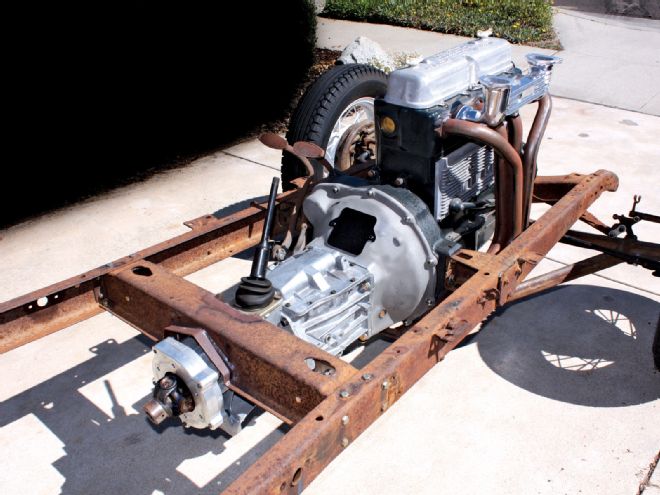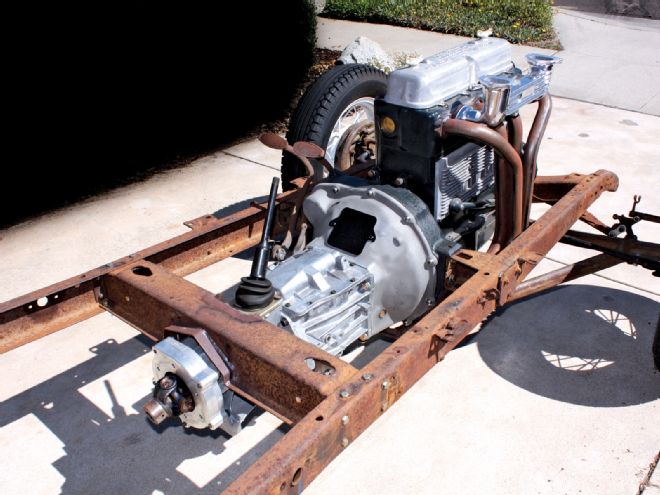
Rodders and restorers are finding themselves more and more on the same page, or at least the same chapter, when it comes to modifying beloved old Fords. The agendas of the two groups are now separated by a gap, rather than a chasm. While hot rodders are leaning toward traditional approaches, the graybeards with stock Model A's and V8s have learned to enjoy their vehicles more by adding more modern touches for safety and performance.

A truly stock Model A or other car of the period is somewhat of a hazard on roadways dominated by brightness-engineered head- and taillights, side lights, turn signals, and horsepower to spare, plus ABS systems that stop on a dime and give back a nickel in change. An 80-year-old wheezer entering the blur of the freeway or forced to make a quick stop is in a tough spot. Owners of such cars try not to do too much night driving, either, considering their "fireflies-in-a-jar" illumination.
The touch of nontraditionalism we're addressing here is adapting the five-speed T5 transmission to a flathead-, or overhead-V8-, or 'banger-powered car. However, the "charm" is the same: utilizing a modern transmission while retaining the closed-drive torque tube. Model A guys like their cars to look stock from an under-the-rear-bumper view, and traditional rod builders will approve for the same reason. Contrary to what one might gather from modern trad-rod events and magazines, the majority of street hot rods of the '40s had neither a Halibrand QC nor an open-driveline conversion.
A friend to both camps of enthusiasts is Steve Serr. His Miller Hi-Speed Head Co. launched with the enormous challenge of redesigning and producing the 126hp overhead conversion, but many other convenience and performance pieces have followed. Serr is dedicated to the '28 to '34 four-bangers. He has provided great improvements in performance and reliability for these cars, but it nagged him that even with hydraulic brakes and extra power his customers were still stuck with a clunky, nonsynchronized transmission with only three speeds. A few years ago, someone started making an adapter plate to join a T5 five-speed to a Model A truck (AA) or '32 to '34 truck (BB) bellhousing. With that, a car with an improved powerband could be utilized more efficiently. Serr sold these adapters until the price of an original, cast-iron truck bellhousing escalated from $10 to $100-plus and the supply of good, uncracked units was exhausted. This started him thinking about a whole new line of bellhousings.
Cast of modern aluminum and CNC machined, his aftermarket kits bolt right up to A and B 'bangers and flatheads. The Model A center crossmember must be modified to clear the rear of the T5, which requires cutting out a portion of steel in the front and back. There's not much beef in a stock A-bone center crossmember, so the kit contains weld-in pieces that reinforce those areas, plus a full-length, bolt-in piece that stiffens the whole crossmember. Four-bangers are mounted up front and at each side of the bellhousing area for a three-point stance of support. Thus, the aluminum T5 doesn't require a rear mount when bolted to the bellhousing. Compared with a Model A three-speed and its bell, the T5 and new aluminum bell add only 4 pounds.
A major hassle in utilizing an original, closed driveline in a modified vehicle has always been changing the length of the torque tube and shaft. The pinion gear on the rear of the driveshaft attaches to the shaft on a taper with a keyway, further secured by a nut behind the pinion gear. Hot rodders in the middle ages would simply cut a chunk of shaft somewhere in the middle, then chuck the two pieces in a lathe and arc-weld them together.
A slightly more successful method involved beveling both pieces, turning a round peg on one piece and a corresponding hole in the other piece, then pushing them together before the arc-welding. You could cut from the front end of the shaft, but making a new set of six splines machined to mate with the large U-joint inside the front "ball" of the torque tube was expensive. The "hobbing" shops that cut gears and teeth were too busy with steady production work to bother with hooligans who cut up cars. Racers would also avoid cutting the rear of the shaft because it was difficult to machine the long taper and keyway. The outer torque tube itself also needed to be shortened the same length and welded.
In the Miller Hi-Speed conversion, the torque tube is shortened roughly 9.5 inches to accommodate the longer length of the T5 and its new bellhousing. Pains are taken to ensure that the two sections align and fit well. An alignment line is marked along the torque tube before any cutting, so the finished tube will still have the front tab (for mounting the rear radius rods) to remain pointed straight down. The tube is cut in the lathe 1.5 inches ahead of the original weld near the rear axle. About half of the wall thickness of the two parts is machined, on the inside diameter on one piece and the outside diameter on the other, for alignment. The new weld is nearly invisible, since the chosen section of the tube is nearly straight, not tapered like the rest of the tube. The two pieces must be clocked as stock before welding. The average garage or machine shop of the '40s was not always successful shortening the tapered portion of the internal shaft. Subtracting those 9.5 inches (your vehicle may be different if you have engine setback) out of the internal shaft was handled by shortening the rear and machining a new taper, keyway, and threads to secure the pinion nut.
The two rear radius rods must also be shortened, although not by the exact length as the torque tube, since the radius rods bolt to the torque tube at an angle. The cut is made at the front section because it has the least amount of taper. Cut the front enough to extricate the cast-steel bungs from the tubes, then weld the bungs into the shortened radius rods. You will also have to heat and slightly bend the rear mounting flanges of the radius rods where they attach to the rearend.
All of these procedures took time to refine, but Serr outdid himself, hooking up the shortened early Ford torque tube to the T5 tailshaft. If you've never seen this end of a Ford closed drive disassembled, there is a large U-joint inside. One end slides over the inner shaft, the other end over the transmission output shaft. This is all contained by a series of seals and steel cups that allows the driveline to move up and down while preventing lubricant leakage. This conversion's tube-to-trans mounting requires an adapter, designed by machinist and rodder Dan Bridges of Aggressive Engineering. Although complicated to make, the piece slips onto the T5, bolting up with five bolts. Now you're ready to roll your rear-axle assembly/torque-tube up and bolt it on, just like a stock early Ford installation. Three adapters cover the different bolt patterns of Model A's ('28; '29; '30 to '31). The newest adapter is for '32 to '48 V8 torque tubes, and you trad-rod guys are gonna love it. A modern, open-drive driveshaft hooked to a 9-inch Ford rearend may be fine for the rest of us, but when you're going for the early style and feeling, only the period look of a closed Ford driveline completes that '40s-early-'50s groove.
Some rodders will choose to make their own pedal assemblies, but for you restorers who want everything right where it used to be, Serr makes two brackets that bolt to the new bellhousing and utilize a common shaft in the same diameter as a stock A. Your pedals fit right on. The flat top of the T5 transmission and the numerous bolts that secure it to the case seemed ready-made to add brackets to mount your original E-brake handle on one side and a modern master cylinder on the left.
The T5 has had several variations over its OEM lifetime, but the trannies suitable for this driveline conversion are GM models. Units from V6 applications are strong enough for any 'banger. The ideal combo merges the basic T5 with a 4WD tailshaft from an S-10, S-15, Jimmy, or Blazer. (Serr cautions not to use the four-cylinder T5s, which have a wicked-low granny First gear.) The short, 4WD tailshaft puts the shifter tower farther forward, mimicking the stock early Ford location. Serr gets his rebuilt T5s with short tailshafts from Anaheim Gear. If you want to use a T5 behind your Cad/Buick/Olds or another engine making more than 175 hp, use the world-class V8 T5 from Camaros and Firebirds or '93-and-later Ford applications (again, with a 4WD tailshaft housing).
If there's any part of this conversion that neither restorers nor rodders will like, it's the ugly, modern shifter. Luckily, there's a simple fix. Many T5s have a handle that unbolts from a stub on the shift tower, for which Lokar offers bolt-on, retro-style shifters. If your handles does not unbolt, Lokar also has two adapters (PN 1070 or 1071) that accept its retro shifters. Serr carries a shifter mount from McLeod that moves the shifter forward to within less than 2 inches of the stock A location.
If you've been driving an old Ford with an original banjo rearend, you might be tired of its too-tall gear ratio. The T5 delivers close-ratio gearing, and, if you have hopped your 'banger or installed a souped flattie or overhead, you now have the power to take advantage of the T5's overdriven Fifth gear on the highway, while enjoying smoother, quieter shifting. Onlookers will stop catcalling about "Grind me a pound, Grandpa!" If you're the Pasadena Reliability Run kind of traditionalist, your modern transmission won't even be noticed by most observers. Anyone who does get wise will probably want a kit of his own.